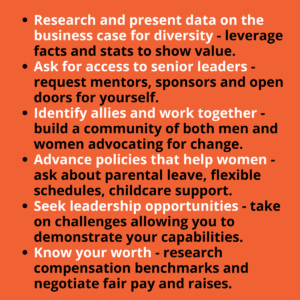For the first time in the history of the Fortune 500, women are leading 10% of the United States’ largest companies by revenue.
It might not feel like much of a leap, but it is a milestone nonetheless. Seeing women in these roles, achieving success and delivering results at the top of their industries, the more motivated and vindicated the push for gender parity. It is also encouraging to see gains in the traditionally male-dominated industries including financial services, defense contracting and manufacturing.
As reported in Forbes, several women have risen to CEO positions in the utility industry as well, with women in charge at Duke Energy, Pacific Gas & Energy, MidAmerican Energy and American Electric Power, among others.
There are still many sector-specific challenges. For example, the number of women in chemical manufacturing remains extremely low; less than 30% of the over 10 million people in this industry are women. Just 31% of IT employees are women, according to Gartner research. Attrition continues to be a big issue in these industries, although initiatives like flexible working are helping, there still needs to be more transparent discussion around workplace equity.
In the early part of my career, I worked as an engineer and program manager in the male dominated oilfield services industry. At times I was the sole female on the team.
At one point I returned from maternity leave and encountered a new manager who was not as flexible as my previous manager, and we didn’t get along very well. To make matters worse, the role I was given was less appealing than the one I had before. I worked to make the role more valuable, but the relationship was still full of contention. The stress and strife overwhelmed me. I struggled to leave my child at daycare so that I could go to a job and work environment where I didn’t feel valued and I did not love spending time. My performance didn’t waiver, but it took an excessive amount of energy to excel in this environment.
One of the many things I learned during this period was: “You can have it all, but not always at the same time.”
The experience forced me to really focus on what I wanted, to prioritize and plan for a future of my own design and, ultimately, the birth of 2Hill Consulting. The experience still informs my approach today – whether I am coaching emerging leaders or working with executive teams to improve the organization’s leadership and transformation capabilities. Thankfully today we have a lot more compelling data and stories to support the case for diverse workforces, but there’s still more to be done.
If you are a leader, especially in traditionally male-dominated industries, here are seven strategies to help increase female representation:
- Examine and address biases in hiring and promotion processes. Even the language you use in a position description can contribute to the structural barriers holding women back.
- Implement mentoring and sponsorship programs to support women’s advancement. Connect women employees with senior leader mentors.
- Offer leadership development and skills training programs specifically for women to build confidence and capabilities.
- Highlight female role models who have succeeded in your industry. Promote their stories both internally and externally.
- Partner with organizations that build STEM skills and interest amongst girls and young women. The pipeline must be strengthened early on.
- Provide flexibility and support systems for mothers to balance work and family demands through generous parental leave, flexible work schedules, and childcare stipends.
- Sponsor employee resource groups empowering women to connect, gain access to senior leaders, and invite external women guests to speak.
Early in your career it can be hard to make an impact, but this is the time to state your ambitions! Here’s some ways in which you can advocate for yourself in the workplace:

By shining a light on representation gaps, advocating for policy change, speaking up and taking on leadership opportunities, we can power progress.






